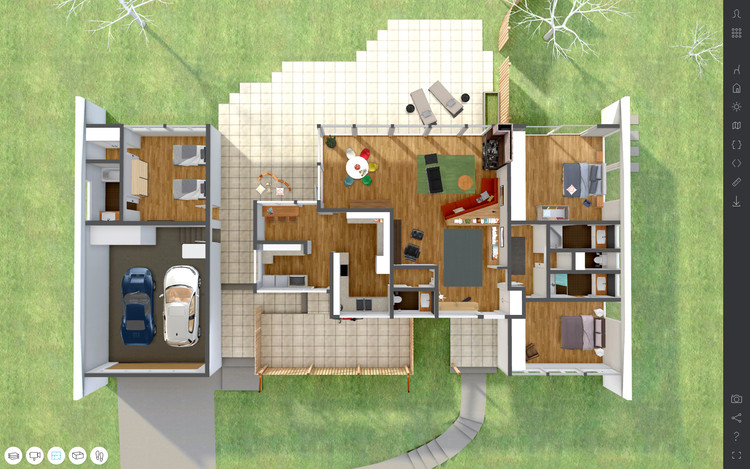
This month's Archilogic model is a virtual tour of the very first Case Study House being featured in Arts and Architecture Magazine's program, designed by Julius Ralph Davidson. After World War II, American soldiers returned home from battlefields in Europe. They had to cope with traumatic experiences during the war and probably just wanted to rebuild their life and settle down.
It must have been hard to get back to normal. Certainly people wanted to live the American Dream: The pursuit of happiness, the intention of all Americans. Life, liberty and the pursuit of happiness was first proclaimed in the United States Declaration of Independence in 1776 and became a sort of “doctrine” for American citizens. This was an idea often reflected in the Hollywood film and television industry. The films that were produced in Hollywood after 1945 were stories that suggested that every hard-working person would succeed. Hollywood seemed to repeatedly produce stories of the American Dream.
Maybe the soldiers who came back had a dream. Maybe they imagined buying a house for themselves and their families. In 1945 Entenza, the editor of Arts and Architecture, wrote: "We of course assume that the shape and form of post war living is of primary importance to a great many Americans, and that is our reason for attempting to find at least enough of an answer to give some directions to current thinking of the matter." Entenza had published an announcement in Arts and Architecture in which he declared the aim of the Case Study House program that he had initiated. It was a program of contemporary model homes, designed by renowned architects such as Eero Saarinen and Richard Neutra, but nevertheless available for all. The big question was whether the postwar generation was ready for modernism.
Entenza was eager to find out. He started his program in 1945. Case Study House #1 was designed by Julius Ralph Davidson, a German who came to California in 1923. In London and Paris he worked as an interior designer, which was his primary occupation during his first years in America. The duplex house that Davidson planned was similar to an earlier house he had designed for the émigré German writer Thomas Mann. For that design, Mann preferred a more “gemütlich” (cozy) version of the International Style, which in his eyes was not the style offered by that other famous architect of Californian homes, Richard Neutra.

Unfortunately, Case Study House #1 did not attract any clients. It took three years before a family with two working parents came forward. Davidson revised the original plans into a compact and efficient one-story house with a standard wood frame construction on a concrete slab floor, built on a gently sloping lot in North Hollywood. He assembled inexpensive materials such as concrete block, plywood panels and industrial glass. His open floor plan with multi-purpose rooms was a characteristic also visible in most of the later Case Study Houses. Since Davidson had, earlier in his life, designed the interiors of ships, all bedrooms had built-in cabinets and closets. An indoor-outdoor experience was made possible by floor-to-ceiling glass with easy access to the gardens.

In an essay for the book Blueprints for Modern Living: History and Legacy of the Case Study Houses, Dolores Hayden wrote that Mrs. X, who would live in the house, could be described as a sort of a circus juggler, who attends easily to the preparation of quick meals in the kitchen adjacent to the bedroom-wing while she is dressing up. However contrary to this feminist critique leveled in 1989, Davidson imagined women as part of the working generation and not as domestic housewives who splish-splashed in the pool when taking a break from housework.

Case Study House #1 had a big influence on Entenza's program of modern experimental architecture by introducing open floor plans and standardized materials, and as a result the house now has a place on the National Register of Historic Places.
We encourage you to experience Archilogic's Virtual Experience in your Browser, create your own designs and share your tours online. To join the Archilogic Platform Sign up here and enjoy the free trial version of the pro subscription.
Archilogic transforms 2D floor plans into interactive, accessible and customizable 3D virtual tours in 24 hours from $69 upwards. Don't miss Archilogic's previous models shared on ArchDaily:
- Case Study House #9 / Charles Eames and Eero Saarinen
- Case Study House #6 / Richard Neutra
- Case Study House #22 / Pierre Koenig
- Case Study House #21 / Pierre Koenig
- Case Study House #8 / Charles & Ray Eames
- Farnsworth House / Mies van der Rohe
- Barcelona Pavilion / Mies van der Rohe


